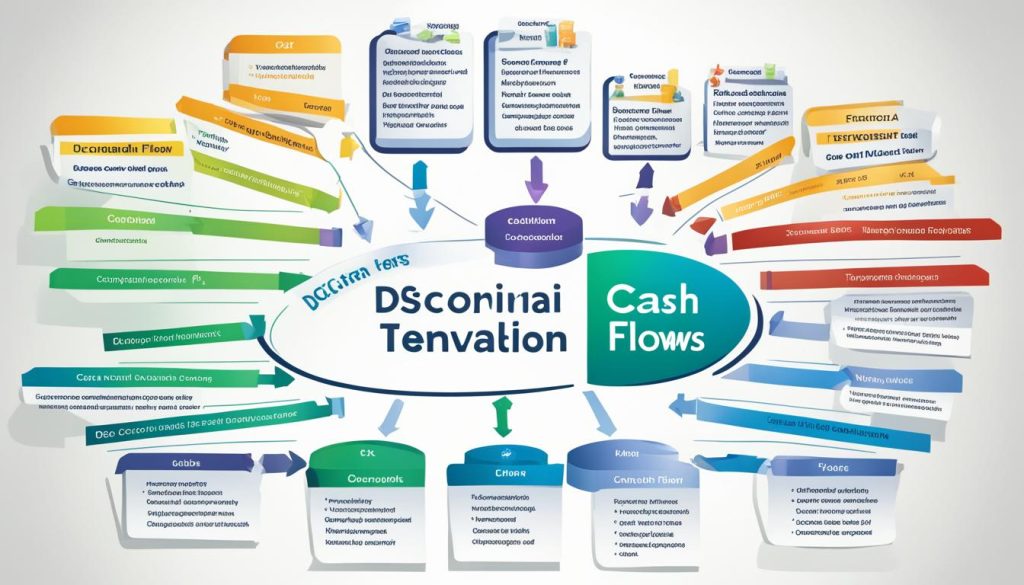Welcome to our comprehensive guide on valuing wealth management firms. Determining the value of a wealth management firm is a critical step in mergers and acquisitions (M&A) transactions. By using various valuation methods, investors and financial professionals can assess the worth of these firms accurately. In this article, we will explore the different strategies and approaches for valuing wealth management firms, providing you with valuable insights into this complex process.
Key Takeaways:
- Valuation procedures play a crucial role in M&A transactions involving wealth management firms.
- Methods such as Comparable Company Analysis, Precedent Transaction Analysis, Discounted Cash Flow Analysis, Asset-Based Valuation, and Earnings Multiples are commonly used to determine the value of these firms.
- Factors like financial performance, market position, industry conditions, intellectual property, synergies, management team, legal and regulatory factors, and financial leverage contribute to a company’s valuation.
- Comparable Company Analysis compares the target firm to similar publicly traded companies to estimate its value based on valuation multiples like the price-to-earnings ratio.
- Precedent Transaction Analysis involves analyzing completed M&A deals in the industry as benchmarks for valuation.
Comparable Company Analysis (CCA)
When valuing a wealth management firm, one method commonly used is Comparable Company Analysis (CCA). This approach involves comparing the financial metrics of the target firm to similar publicly traded companies within the same industry. By analyzing valuation multiples such as the price-to-earnings (P/E) ratio, investors can estimate the value of the target firm and make informed investment decisions.
Comparable Company Analysis provides valuable insights into the market perception and investor sentiment surrounding similar companies. It helps to gauge the relative value of the target firm by considering the performance and valuation of comparable peers.
To conduct a CCA, financial analysts identify a set of comparable companies based on factors such as industry, business model, size, and growth prospects. They then examine key financial ratios and multiples, including the P/E ratio, which compares a company’s market price per share to its earnings per share.
This approach allows investors to understand how the target firm’s valuation compares to its peers. A higher P/E ratio indicates that the market has a positive outlook on the firm’s future earnings growth potential. Conversely, a lower P/E ratio might suggest that the market perceives higher risk or lower growth prospects.
By analyzing the valuation multiples obtained through Comparable Company Analysis, investors can gain valuable insights into the target firm’s market value and make strategic investment decisions. It’s important to note that CCA should be used in conjunction with other valuation methods to ensure a comprehensive understanding of the firm’s underlying value.
Example of Comparable Company Analysis
- Select a group of publicly traded wealth management firms that are comparable in terms of size, business model, and growth outlook.
- Collect financial data such as revenue, net income, and market capitalization for each company.
- Calculate relevant valuation multiples, including the price-to-earnings ratio.
- Compare the valuation multiples of the target firm to those of its peers.
- Analyze the relative valuation and determine an estimated value for the target firm based on the findings.
Using the Comparable Company Analysis method, investors and analysts can gain a better understanding of the target firm’s valuation and make informed investment decisions. It provides a valuable benchmark for estimating the fair value of a wealth management firm in relation to its peers.
Precedent Transaction Analysis (PTA)
When it comes to valuing a wealth management firm, Precedent Transaction Analysis (PTA) is a powerful tool used in M&A transactions. This method involves analyzing completed deals within the same industry to estimate the value of the target company.
By examining the valuation and multiples paid in similar transactions, financial experts can establish benchmarks for the valuation of the wealth management firm under evaluation. This analysis helps determine a reasonable price range based on historical M&A transaction data.
PTA takes into account various factors, such as the size and scope of the previous deals, the financial performance of the companies involved, and the nature of the transactions. This approach provides valuable insights into market trends, pricing dynamics, and the overall valuation landscape within the wealth management industry.

“Precedent Transaction Analysis enables industry professionals to gain a comprehensive understanding of the market’s perception of wealth management firms. By examining past M&A transactions, we can identify key value drivers and evaluate how they may impact the target company’s valuation.”
Having access to a robust database of precedent transactions is essential for conducting an accurate and reliable analysis. This information allows valuation professionals to identify relevant comparables and adjust for any differences in size, growth prospects, or synergistic potential between the target firm and the completed transactions.
With the insights obtained from Precedent Transaction Analysis, professionals can make informed decisions about the valuation of the wealth management firm, taking into consideration the unique characteristics of the company and the prevailing market conditions.
Discounted Cash Flow (DCF) Analysis
When valuing a wealth management firm, one commonly used method is the Discounted Cash Flow (DCF) Analysis. This approach estimates the present value of the firm by projecting its future cash flows and then discounting them back to the present. By taking into account the time value of money, the DCF Analysis provides a comprehensive valuation framework.
To begin the DCF Analysis, the first step is to forecast the future cash flows of the wealth management firm. This involves making assumptions about revenue growth, profit margins, and other relevant financial factors. The more accurate these projections, the more reliable the valuation.
“The DCF Analysis is a powerful tool for determining the value of a wealth management firm. By considering the future cash flows and applying the appropriate discount rate, investors can derive the present value of the firm.”
Once the future cash flows are projected, the next step is to apply a discount rate. The discount rate is used to account for the time value of money and the risk associated with the investment. Factors such as the firm’s cost of capital, industry risk, and market conditions are taken into consideration when determining the discount rate.
With the projected cash flows and discount rate in place, the final step is to calculate the present value of these future cash flows. This involves discounting each cash flow back to the present using the chosen discount rate. The sum of these discounted cash flows represents the estimated value of the wealth management firm.

The Discounted Cash Flow Analysis provides a holistic valuation approach that takes into account the future potential of the wealth management firm. By considering both the present value and future cash flows, investors can make informed decisions about the value and investment potential of a specific firm.
Asset-Based Valuation
When it comes to determining the value of a wealth management firm, one of the commonly used methods is Asset-Based Valuation. This approach involves assessing the net asset value of the firm by calculating the total value of its tangible and intangible assets and then subtracting its liabilities.
Net asset value, also known as NAV, is a crucial component of Asset-Based Valuation. It represents the fair market value of a firm’s assets after deducting its liabilities. Tangible assets, such as real estate, equipment, and inventory, are easily quantifiable. On the other hand, intangible assets, such as brand reputation, intellectual property, and client relationships, are more challenging to value but play a significant role in a firm’s overall worth.
By including both tangible and intangible assets in the valuation, Asset-Based Valuation provides a comprehensive assessment of a wealth management firm’s financial position. This method offers a clearer understanding of the firm’s intrinsic value, taking into account its physical and non-physical assets. While other valuation methods focus on financial performance and market comparisons, Asset-Based Valuation considers the tangible assets that form the foundation of the firm’s operations and the intangible assets that contribute to its competitive advantage in the market.
Implementing Asset-Based Valuation requires a diligent evaluation process. A thorough analysis of the firm’s balance sheet, which outlines its assets and liabilities, is necessary. This evaluation involves assessing the current market value of tangible assets and determining how intangible assets contribute to the firm’s overall value. By considering both types of assets, a more accurate valuation can be achieved.
Asset-Based Valuation is particularly useful in situations where a wealth management firm’s financial performance may not accurately reflect its true value. For instance, if a firm’s revenue is currently low due to temporary factors or market conditions, Asset-Based Valuation can provide a more accurate representation of its underlying worth.
“Asset-Based Valuation offers a comprehensive view of a wealth management firm’s value by considering both tangible and intangible assets.”
Ultimately, Asset-Based Valuation provides a holistic perspective on a wealth management firm’s worth. By incorporating the net asset value, tangible assets, and intangible assets, this method offers a more comprehensive understanding of a firm’s intrinsic value. While other valuation methods focus on financial performance or market comparisons, Asset-Based Valuation ensures that both the physical and non-physical assets of the firm are considered in determining its true worth.

Earnings Multiples
Earnings Multiples are a widely-used method for valuing a wealth management firm. This approach involves evaluating the company’s earnings or cash flow and applying a multiple to estimate its valuation. A common multiple used is the price-to-earnings (P/E) ratio, which compares the company’s stock price to its earnings per share. By analyzing this ratio, investors and analysts can gain insights into a company’s financial health and growth potential.
The price-to-earnings ratio is calculated by dividing the market price per share by the company’s earnings per share. It provides a snapshot of the market’s expectations about the company’s future performance. A higher P/E ratio may indicate that investors have high expectations for future earnings growth, while a lower ratio may suggest lower growth prospects or undervaluation.
When valuing a wealth management firm using earnings multiples, it’s essential to consider the industry’s average multiples to ensure accuracy. Factors such as market conditions, industry trends, and the company’s growth prospects can influence these multiples. Additionally, other multiples, such as the price-to-sales ratio or price-to-cash flow ratio, can also be used to provide a comprehensive view of the company’s valuation.




No comments! Be the first commenter?